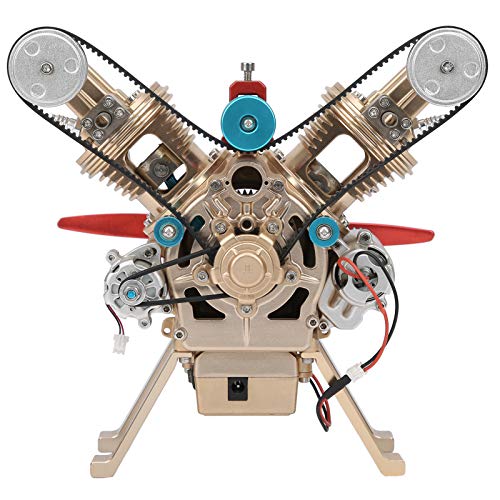K
Kludge
Guest
Okay, its blue-sky time.
As some of you know, Ive got a small project sitting on the sidelines in the form of a Nick Ziroli 101 wingspan B-25. For this, I need a pair of fairly decent engines. According to the design spec, the Ryobi 26 & 31cc 2 and 4-stroke lawn trimmer (weed whacker) engines are good which is convenient since theyre cheap, available and pretty cool.
Ahhh, but its max gross is 35 pounds and I fear the take off weight may well exceed that. It will be getting some of the more advanced lift and performance improving tricks (civilianized with no turrets plus other airframe changes for streamlining and weight reduction, wing tiplets, improved flaps, etc) which may net be another couple pounds of lift with the same power but pumping the engines up will help some as well. So that what this is about pumping up the engines so they can give me a bit more power.
Increased compression is one path. Since the heads and cylinders are all one piece, this means shaving the base of the cylinders instead of the top. Im not sure how far this can be pushed but the engines are cheap enough to find out. There are also porting and relieving, variable ignition timing, modified cams or electrically operated valves, and tuned intake and exhaust systems. (This was covered in an earlier thread.) Ram intake would also be good though it will only help with increased airspeed. In other words, on takeoff when the added power would be really nice, its not there. I also thought about a supercharger (mechanical or turbo-driven) but came to the conclusion it would take more to drive it than Id gain.
The 4-stroke engines may benefit from fuel injection, either throttle body or direct injection at the intake valve. (Ive thought about injection directly into the cylinder but never came up with a way to handle that due to the pressures and heat involved.) The floatless carburetors used on these engines are fairly close to the pressure carbs used on WW II aircraft engines with the exception that there is no altitude compensation. (Admission time: My favorite of those was the Holley variable venturi carb one huge variable-width rectangular hole that lead straight to the intake manifold. Beautiful!) The concept isnt far off from that of the body part of a throttle body injection system so that wouldnt be a difficult conversion.
Stepping up to direct injection takes a bit more, though aircraft systems when I was still an aircraft mechanic were pretty simplistic. Even so, not much would have to be sensed in comparison to an automotive system rpm, demand (throttle position), intake air temp, ambient air pressure, and either cylinder head or exhaust gas temp. With radio control available, there would be three mixture conditions full rich, automatic and idle cutoff. Full rich (still kind of automatic) would be for take off & climb out, landing and other times when I may wind up needing full power in a hurry. Automatic would be an economy setting controlled by ambient air temp, CHT or EGT, demand vs. engine speed and probably one or two other variables. Idle cutoff well, thats how we shut down piston pounders, starve them of fuel. All of this would be under the control of a microprocessor with the default in case of failure being full rich.
On the other hand, 2-stroke engines present a few problems as far as the fuel systems go. The most common system is a floatless carb like the 4-stroke engines use only with a fuel/oil mix instead of plain fuel. Like with the 4-stroke engines, these lend themselves well to throttle body fuel injection, though I cant say Ive ever seen a system like that on a lawn trimmer. (On the other hand, lawn trimmers are designed to be inexpensive hence easily replaceable.) At the same time, Ive never seen anything close to a direct injection system either though I think it would be possible. Sort of. A constant oil feed for the bottom end for a given engine speed and an independent fuel feed as defined with the 4-stroke direct fuel injection would, to my mind, be an ideal solution but not one easily achieved with current designs.
Okay, so what might work? And I do emphasize might most strongly. The first step would be to separate the fuel and oil feed to the engine. The second would be to remake the carb (such as it would wind up) so the oil feed is directly controlled by engine speed not fuel demand but is still misted into the air feed The third would be to install an injection nozzle at the intake port controlled by the same type of processor & sensors as the 4-stroke engine so metered fuel is introduced sometime during the intake portion of the cycle. When? Im not sure though it would be convenient if there was minimum fuel loss out the exhaust port for economy purposes.
Since the engines will be operated at pretty constant speeds and loads for the greater part of their operating life rather than blipped as they would be as lawn trimmers the fuel, ignition, intake, exhaust and lubrication systems can all be modified to suit. This greatly simplifies things as far as design goes since it can be tuned to cruising conditions about 75% throttle, straight and level, 100-500 absolute altitude with what adjustments are needed to provide full power when required plus to prevent overheating in other than cruise conditions. Another factor is that the airplane will be spending most of its time right side up like a proper (civilian) airplane rather than designed for aerobatics including inverted flight even though the engines were originally designed for operating in any position.
Ill cover the on-board electronics another time but its sufficient to say theyre a bit more than most R/C aircraft fly with, even giant scale which this will be.
Anyway, this is just in the idea stage right now. Im in no position to even consider the merest thought of starting this project and wont be for quite a while.
As some of you know, Ive got a small project sitting on the sidelines in the form of a Nick Ziroli 101 wingspan B-25. For this, I need a pair of fairly decent engines. According to the design spec, the Ryobi 26 & 31cc 2 and 4-stroke lawn trimmer (weed whacker) engines are good which is convenient since theyre cheap, available and pretty cool.
Ahhh, but its max gross is 35 pounds and I fear the take off weight may well exceed that. It will be getting some of the more advanced lift and performance improving tricks (civilianized with no turrets plus other airframe changes for streamlining and weight reduction, wing tiplets, improved flaps, etc) which may net be another couple pounds of lift with the same power but pumping the engines up will help some as well. So that what this is about pumping up the engines so they can give me a bit more power.
Increased compression is one path. Since the heads and cylinders are all one piece, this means shaving the base of the cylinders instead of the top. Im not sure how far this can be pushed but the engines are cheap enough to find out. There are also porting and relieving, variable ignition timing, modified cams or electrically operated valves, and tuned intake and exhaust systems. (This was covered in an earlier thread.) Ram intake would also be good though it will only help with increased airspeed. In other words, on takeoff when the added power would be really nice, its not there. I also thought about a supercharger (mechanical or turbo-driven) but came to the conclusion it would take more to drive it than Id gain.
The 4-stroke engines may benefit from fuel injection, either throttle body or direct injection at the intake valve. (Ive thought about injection directly into the cylinder but never came up with a way to handle that due to the pressures and heat involved.) The floatless carburetors used on these engines are fairly close to the pressure carbs used on WW II aircraft engines with the exception that there is no altitude compensation. (Admission time: My favorite of those was the Holley variable venturi carb one huge variable-width rectangular hole that lead straight to the intake manifold. Beautiful!) The concept isnt far off from that of the body part of a throttle body injection system so that wouldnt be a difficult conversion.
Stepping up to direct injection takes a bit more, though aircraft systems when I was still an aircraft mechanic were pretty simplistic. Even so, not much would have to be sensed in comparison to an automotive system rpm, demand (throttle position), intake air temp, ambient air pressure, and either cylinder head or exhaust gas temp. With radio control available, there would be three mixture conditions full rich, automatic and idle cutoff. Full rich (still kind of automatic) would be for take off & climb out, landing and other times when I may wind up needing full power in a hurry. Automatic would be an economy setting controlled by ambient air temp, CHT or EGT, demand vs. engine speed and probably one or two other variables. Idle cutoff well, thats how we shut down piston pounders, starve them of fuel. All of this would be under the control of a microprocessor with the default in case of failure being full rich.
On the other hand, 2-stroke engines present a few problems as far as the fuel systems go. The most common system is a floatless carb like the 4-stroke engines use only with a fuel/oil mix instead of plain fuel. Like with the 4-stroke engines, these lend themselves well to throttle body fuel injection, though I cant say Ive ever seen a system like that on a lawn trimmer. (On the other hand, lawn trimmers are designed to be inexpensive hence easily replaceable.) At the same time, Ive never seen anything close to a direct injection system either though I think it would be possible. Sort of. A constant oil feed for the bottom end for a given engine speed and an independent fuel feed as defined with the 4-stroke direct fuel injection would, to my mind, be an ideal solution but not one easily achieved with current designs.
Okay, so what might work? And I do emphasize might most strongly. The first step would be to separate the fuel and oil feed to the engine. The second would be to remake the carb (such as it would wind up) so the oil feed is directly controlled by engine speed not fuel demand but is still misted into the air feed The third would be to install an injection nozzle at the intake port controlled by the same type of processor & sensors as the 4-stroke engine so metered fuel is introduced sometime during the intake portion of the cycle. When? Im not sure though it would be convenient if there was minimum fuel loss out the exhaust port for economy purposes.
Since the engines will be operated at pretty constant speeds and loads for the greater part of their operating life rather than blipped as they would be as lawn trimmers the fuel, ignition, intake, exhaust and lubrication systems can all be modified to suit. This greatly simplifies things as far as design goes since it can be tuned to cruising conditions about 75% throttle, straight and level, 100-500 absolute altitude with what adjustments are needed to provide full power when required plus to prevent overheating in other than cruise conditions. Another factor is that the airplane will be spending most of its time right side up like a proper (civilian) airplane rather than designed for aerobatics including inverted flight even though the engines were originally designed for operating in any position.
Ill cover the on-board electronics another time but its sufficient to say theyre a bit more than most R/C aircraft fly with, even giant scale which this will be.
Anyway, this is just in the idea stage right now. Im in no position to even consider the merest thought of starting this project and wont be for quite a while.































































